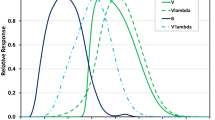Abstract
Deployable Camera 3-D (DCAM3-D) is a small high-resolution camera equipped on Deployable Camera 3 (DCAM3), one of the Hayabusa2 instruments. Hayabusa2 will explore asteroid 162137 Ryugu (1999 JU3) and conduct an impact experiment using a liner shooting device called Small Carry-on Impactor (SCI). DCAM3 will be detached from the Hayabusa2 spacecraft and observe the impact experiment. The purposes of the observation are to know the impact conditions, to estimate the surface structure of asteroid Ryugu, and to understand the physics of impact phenomena on low-gravity bodies. DCAM3-D requires high imaging performance because it has to image and detect multiple targets of different scale and radiance, i.e., the faint SCI before the shot from 1-km distance, the bright ejecta generated by the impact, and the asteroid. In this paper we report the evaluation of the performance of the CMOS imaging sensor and the optical system of DCAM3-D. We also describe the calibration of DCAM3-D. We confirmed that the imaging performance of DCAM3-D satisfies the required values to achieve the purposes of the observation.

























Similar content being viewed by others
References
M. Arakawa, T. Saiki, K. Wada, T. Kadono, Y. Takagi, M. Hayakawa, H. Imamura, K. Ogawa, K. Shirai, R. Honda, K. Ishibashi, H. Hayakawa, Small Carry-on Impactor (SCI): its scientific purpose, operation, and observation plan in Hayabusa2 mission, in Proc. Lunar Planet. Sci. Conf., vol. 44 (2013), p. 1904
M. Arakawa, K. Wada, T. Saiki, T. Kadono, Y. Takagi, K. Shirai, C. Okamoto, H. Yano, M. Hayakawa, S. Nakazawa, N. Hirata, M. Kobayashi, P. Michel, M. Jutzi, H. Imamura, K. Ogawa, N. Sakatani, Y. Iijima, R. Honda, K. Ishibashi, H. Hayakawa, H. Sawada, Science objective of Small Carry-on Impactor (SCI) and Deployable Camera 3 Digital (DCAM3-D): observation of an ejecta curtain and a crater formed on the surface of Ryugu by an artificial high-velocity impact. Space Sci. Rev. (2016). doi:10.1007/s11214-016-0290-z
K. Ogawa, K. Shirai, H. Sawada, M. Arakawa, R. Honda, K. Wada, K. Ishibashi, Y. Iijima, N. Sakatani, S. Nakazawa, H. Hayakawa, System configuration and operation plan of Hayabusa2 DCAM3-D for scientific observation in SCI impact experiment. Space Sci. Rev. (2016, submitted to this issue)
F.R. Sindmey, Applied Photographic Optics (Focal Press, Waltham, 2002)
T. Saiki, H. Imamura, H. Sawada, M. Arakawa, T. Kadono, Y. Takagi, K. Wada, Small Carry-on Impactor of Hayabusa2 and its impact operation, in Proc. Int. Symp. Space Tech. Sci. (2013), p. 29
T. Saiki, H. Imamura, M. Arakawa, K. Wada, Y. Takagi, M. Hayakawa, K. Shirai, H. Yano, C. Okamoto, Small Carry-on Impactor (SCI) for Hayabusa2 impact experiment. Space Sci. Rev. (2016). doi:10.1007/s11214-016-0297-5
H. Sawada, K. Ogawa, K. Shirai, DCAM3 Development Team, Deployable Camera (DCAM3) system for observation of Hayabusa2 impact experiment DCAM3. Space Sci. Rev. (2016, submitted to this issue)
K. Wada, M. Arakawa, T. Saiki, H. Imamura, M. Hayakawa, C. Okamoto, K. Shirai, T. Takagi, T. Kadono, Y. Tsuda, H. Yano, S. Nakazawa, N. Hirata, K. Ogawa, Y. Iijima, P. Michel, M. Jutzi, Large scale impact experiments simulating Small Carry-on Impactor (SCI) equipped on Hayabusa2, in Proc. Lunar Planet. Sci. Conf., vol. 45 (2014), p. 1768
Acknowledgements
The authors thank the engineers of Meisei Electric Co., Ltd. for their dedication in conducting the verification tests of DCAM3-D. We appreciate the assistance in the integrating sphere test from the technicians at JAXA’s Tsukuba Space center. We thank Dr. David C. Humm and Dr. Michael Ravine for their many constructive comments and suggestions that helped improve the manuscript.
Author information
Authors and Affiliations
Corresponding author
Rights and permissions
About this article
Cite this article
Ishibashi, K., Shirai, K., Ogawa, K. et al. Performance of Hayabusa2 DCAM3-D Camera for Short-Range Imaging of SCI and Ejecta Curtain Generated from the Artificial Impact Crater Formed on Asteroid 162137 Ryugu (1999 \(\mbox{JU}_{3}\)). Space Sci Rev 208, 213–238 (2017). https://doi.org/10.1007/s11214-016-0298-4
Received:
Accepted:
Published:
Issue Date:
DOI: https://doi.org/10.1007/s11214-016-0298-4




